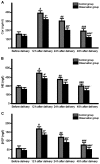Application effect of single balloon catheters in labor induction of pregnant women in late-term pregnancy and their influences on stress and inflammatory responses
- PMID: 29545854
- PMCID: PMC5841050
- DOI: 10.3892/etm.2018.5767
Application effect of single balloon catheters in labor induction of pregnant women in late-term pregnancy and their influences on stress and inflammatory responses
Abstract
This study was designed to evaluate the application effect of single balloon catheters and dinoprostone on promoting cervical ripening of pregnant women in late-term pregnancy and their influences on stress and inflammatory responses. A total of 160 pregnant women with indications of labor induction were included and randomly divided into the control (n=80) and observation (n=80) groups. Patients in the control group received labor induction by administration of dinoprostone at the vaginal vault, while those in the observation group received labor induction by domestic single balloon catheters. Cervical ripening (Bishop score), means of pregnancy, the total stage of labor, maternal and child complications, and Apgar scores of newborn infants at 1 min after delivery between the two groups were compared. At the prenatal and postpartum 12, 24 and 48 h, the levels of cortisol (COR), norepinephrine (NE) and β-endorphin (β-EP), were detected using radioimmunoassay, and those of C-reactive protein (CRP), interleukin-6 (IL-6) and tumor necrosis factor-α (TNF-α), were measured using enzyme-linked immunosorbent assay (ELISA). Cervical Bishop scores in the two groups after intervention were significantly higher than those before intervention, and the score of the observation group was significantly higher than that of the control group. The difference was statistically significant (P<0.05). In the observation group, the total stage of labor was significantly shortened, the Apgar score of the newborn infant at 1 min after delivery was increased compared with those in the control group, and the differences were statistically significant (P<0.05). The delivery rate of cesarean section in the observation group was lower than that in the control group, the overall incidence rate of perinatal complications was decreased, and the differences were statistically significant (P<0.05). The levels of stress and inflammatory response markers at 12 h after delivery in the two groups reached the peak, and then declined (P<0.05). The levels of stress and inflammatory response markers at each time-point after delivery in the observation group were significantly lower than those in the control group, and the difference was statistically significant (P<0.05). The results showed that the single balloon catheter promotes cervical ripening, improves pregnancy outcomes and reduces the stress and inflammatory responses of pregnant women in late-term pregnancy, and is better than dinoprostone and has better application and promotion values.
Keywords: cervical ripening; dinoprostone; inflammatory response; single balloon catheter; stress response.
Figures


References
LinkOut - more resources
Full Text Sources
Other Literature Sources
Research Materials
Miscellaneous
